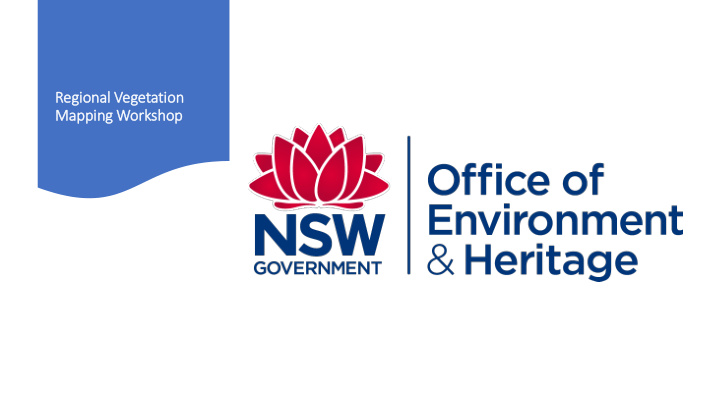



Reg egio ional Veg egetatio ion Map appin ing Work orkshop
Introduction
Workflow
Segmentation of imagery Interpretation of vegetation photo patterns Use of existing vegetation mapping Vegetation structures are interpreted using a range of data in addition to digital imagery including landscape position, survey records, environmental data, existing mapping and local knowledge. Spatial Approximate scale of mapping 1:8,000 for coastal areas up to 1:25,000 for western regions analysis Some structural units include a large number of PCTs (ie Dry Sclerophyll) Vegetation modelling will be specific to structural groupings and utilise particular environmental predictors for each PCT
Code Structural Class Code Structural Class 0 Non-native 21 Wet heath 1 Candidate native grasslands 22 Dry heath 2 Dry sclerophyll 23 Grassy headlands 3 Wet sclerophyll 24 Swamp forest (treed wetlands) 5 Floodplain Forests 26 Foredune 7 Non-woody wetlands 29 Woodland (shrubby) 8 Grassy woodlands & open forest 30 Callitris woodland & forest 9 Dry Rainforest and Vine Thicket 31 Shrubby regrowth 10 Rainforests 32 Riparian River Oak Forest 11 Riparian forests (generic) 33 Riparian Moist Eucalypt Forest 13 Scrub / Tall Heath 34 Riparian rainforests 14 Hanging Swamps 35 Swamp Oak Forest 15 DSF gully/riparian 36 Mallee eucalypt heathy forest/woodlands 16 Rock 37 Riparian shrublands 18 Saltwater wetlands (mangroves/saltmarsh) 38 Camphor laurel dominated forests 20 Littoral rainforest
PCTs are also being attributed to specific polygons where there is sufficient data PCTs are being re-classified across the Vegetation state and the relationships to old and new PCTs will be identified mapping Existing PCT level mapping will be uplifted into the state vegetation map and equivalent PCTs attributed to the relevant polygons
Relationships between vegetation structure, environmental variables and survey records will be established for each PCT and applied across the landscape Each structural grouping will have a separate model of relevant PCTs Some PCTs will extend across several vegetation structures Community distribution Envelopes will be used to constrain modelling to the known distributional and environmental ranges of PCTs modelling Some PCTs will not be modelled due to insufficient data or restricted distributions and mapped manually where there is sufficient site data Evaluation of accuracy will be invited as part of a user testing program and new information will be incorporated into the mapping
PCT Classification
8 Legacy Plot Based Classifications • Upper Murrumbidgee (no PCT) • South Coast and Tablelands SCIVI (PCT) • South Coast Gellie (PCT) • Sydney Basin (part PCT) • Hunter (PCT) • Northern Rivers (draft PCT) • Nandewar (VCA>PCT) • Brigalow Belt South (VCA>PCT)
• Majority of sites have been classified by one or more ‘legacy’ classifications • Legacy classification units are cited by many eastern PCTs
Revising Plant Community Types (P (PCTs) for Eastern NSW Make PCTs easier to use and identify in the field through: • improved coverage of survey data • a new state-wide context and a standard classification methodology • consistent descriptive and diagnostic attributes • better alignment between PCTs and TECs (Threatened Ecological Communities) • improved management of and access to classification data
Targeted sampling
Priority Areas
PROGRESS OF CANDIDATE PCT REVISIONS Stage 1 1. Coastal Grassy Forests x10. Mixed assemblages 2. Western Dry Sclerophyll Forests 3. Eastern New England Forests 4. Tablelands Grassy Forests 5. Rainforests 6. Western Grassy Woodlands 7. Coastal Dry Shrub Forests 8. Coastal Heaths and Heathy Woodlands 9. Coastal Moist Grassy Forests 0 50 100 150 200 250 300 Completed Remaining
• Approx. 5000 sites have been entered into the database since January 2017 - new survey - large effort to acquire and enter existing data from environmental consultants In Integration of etc. new data • New data will - stabilise existing PCTs and improve diagnostic characteristics - propose new PCTs
Recommend
More recommend